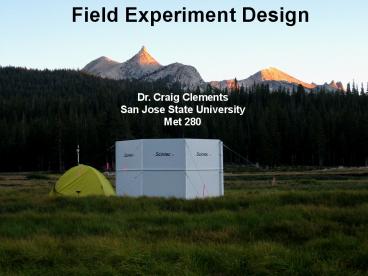Field Experiment Design - PowerPoint PPT Presentation
1 / 26
Title: Field Experiment Design
1
Field Experiment Design
Dr. Craig Clements San Jose State University Met
280
2
Field Experiment Design
Need to determine what phenomena you are
studying e.g. mesoscale winds, sea-breeze,
mountain winds, thunderstorms, turbulence Need
to determine what parameters you need to
measure Winds, (horizontal, vertical),
Temperature, Humidity, Cloud height, and Boundary
layer height. Need to determine spatial and
temporal resolution you want to measure at 1
hour, 1 min, 1 s, 10 km, 1 km, 1 m.
3
Field Experiment Design
- Field experiments require people.
- It is very hard to do it alone!
- People need food and shelter during the campaign
- and this costs
- Field experiments require time
- enough time to measure the desired phenomena
- enough time to set up the instruments
- and time to break down.
4
Balloon Operations in Yosemite Valley, CA 1998
(spring break) Three people operated one site for
5 days, perk free camping
5
Field Work requires late nights and long days
6
Solo Pilot Balloon Operations Lee Vining Canyon,
CA 1996
7
No-Lift Balloons cheap and easy Lake Ellery, Lee
Vining Canyon, CA 1996
8
Data acquisition can be laborious and time
consuming
9
Peter Sinks Experiment
10
Peter Sinks Experiment
The goal of the experiment was To determine the
role of the slope flows on cold air pool buildup
in a mountain basin. So, the experiment was
designed to measure wind and temperatures along
the slopes of the Peter Sinks (one of the coldest
spots in the US, record of -56 C).
11
Aerial photos provide the first glimpse of the
proposed site.
12
Slope in the Peter Sinks that measurements were
focused on. Access along the road. Permission
to use USFS land Need to obtain land-use permits
and FAA permissions. To obtain permits,
experimental plans need to be in
application Therefore, your experimental design
comes first.
13
Maps of the field site are very important. Must
be clear Should have various scales indicating
overall site and topography All maps NEED a
north arrow and a scale.
14
A detailed experimental map includes accurate
instrument locations. Use of clear symbols and
color when appropriate. A legend is required
15
Installing a thermocouple mast on a slope.
16
In-Field Calibrations
17
Alignment of anemometers with a compass.
18
(No Transcript)
19
(No Transcript)
20
(No Transcript)
21
(No Transcript)
22
(No Transcript)
23
(No Transcript)
24
Operations Base Camp
25
Campbell Scientific, Inc. flux tower.
26
Results

